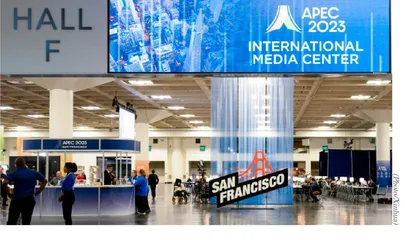Asia-Pacific Regional Economic Cooperation Under the Reshaping of Global Productionand Supply Chains
作者: Liu Chenyang

As part of the important trends of the current development of the world economy, the reshaping of global industry and supply chains interacts with the intensified changes unprecedented in the past century in an increasingly close manner. “Benefit-sharing and risk-sharing”, the characteristics of global industry and supply chains, have a profound influence on the distribution of benefits among countries and the effectiveness of global economic governance. How to maintain the overall security and stability of the global industry and supply chain system under the new circumstances and ensure equal opportunities for all countries to fully participate in the global industry and supply chain have become major substantial issues of great concern to the international community.
At present, the Asia-Pacific region accounts for 60% and 50% of the world’s total economy and trade respectively, and is home to the most important manufacturing and trading countries other than members of the European Union. Since the 1980s, the Asia-Pacific region has become the region with the densest distribution of industry and supply chains globally and the main engine of world economic growth, thanks to regional economic cooperation of all forms, at multiple levels and in different industries. Therefore, expanding and deepening regional economic cooperation in the Asia-Pacific region will not only play a pivotal role in stabilizing and improving the global industry and supply chain system, but will also make an important contribution to an open world economy.
Drivers and Trends of Global Industry and Supply Chain Reshaping
The reshaping of global industry and supply chains is driven by a combination of factors, both economic and non-economic. An in-depth analysis of the drivers and trends of the reshaping of global industry and supply chains will help us fully understand the significance of deepening regional economic cooperation in the Asia-Pacific region and identify the direction and priority areas for future cooperation.
In terms of economic factors, global industry and supply chains have evolved alongside economic globalization, and their reshaping is directly related to the trends of “anti-globalization” and “re-globalization” that have emerged in recent years. After the international financial crisis in 2008, the world economy and trade have fallen into a relatively long-term structural downturn, and some countries and regions have seen the emergence of thoughts and actions that are contrary to the globalization, represented by protectionism, unilateralism and populism. At the same time, the World Trade Organization (WTO) Doha Round of Trade Negotiations has been delayed for a long time, and the reform of the multilateral trading system has been difficult, which has had a negative impact on the macro environment for the development of the global industry and supply chain.
The digital economy and the green low-carbon economy have also had a significant impact on the features and development direction of global industry and supply chains. The digital economy’s role in innovating growth models, raising labor productivity, cultivating new markets and new growth points for industries is becoming more important, triggering an all-round transformation of the global supply chain in various aspects, including production, distribution, sales and consumption. The promotion of low-carbon transformation and green development, with multilateral cooperation to address climate change as the background and motivation, has given rise to an international environmental regime covering the three major elements of energy supply and demand, economic competitiveness and environmental quality, and how to obtain greater space for economic development under environmental constraints has become an important goal pursued by all countries. In recent years, the influence of the digital economy and the green low-carbon economy on the form of the international industrial division of labour, the composition of globalization participants and the relevant international economic and trade rules has been more and more profound, thus accelerating the reshaping of the global industry and supply chain.
From the perspective of non-economic factors, the possibility of fundamental changes of the international environment with peace and development as the theme of the times is gradually increasing in the current and future period, with frequent regional conflicts and intensifying geopolitical games, which have caused serious impacts on the stability of the global industry and supply chain system. As a matter of fact, compared with regional conflicts, the destruction by geopolitical games in the guise of economic cooperation, exclusion and “decoupling and breaking the chain” in the name of cooperation, and the politicization, ideologization and even weaponization of economic affairs are devastating and far-reaching to the global industry and supply chain.
Under the influence of the above superimposed factors, the reshaping of the global industry and supply chain embodies localization, regionalization and shortening chain in terms of location and spatial distribution, as well as digitalization, intelligence and greening in terms of directions of transformation and upgrading. Its overall development trend can be summarized as follows: enhancing security of the industry and supply chain by strengthening its self-reliance and controllability, enhancing the resilience of the chain through multi-dimensional layout, and adjusting the distribution pattern of interests of the industry and supply chain by creating new rules for trade and economy, as well as expanding spaces for industry and supply chain by modern science and technology innovation.